ASUS Z97-Pro WiFi AC Review
by Ian Cutress on July 16, 2014 10:00 AM EST- Posted in
- Motherboards
- Asus
- Haswell
- 802.11ac
- Z97
CPU Benchmarks
Readers of our motherboard review section will have noted the trend in modern motherboards to implement a form of MultiCore Enhancement / Acceleration / Turbo (read our report here) on their motherboards. This does several things – better benchmark results at stock settings (not entirely needed if overclocking is an end-user goal), at the expense of heat and temperature, but also gives in essence an automatic overclock which may be against what the user wants. Our testing methodology is ‘out-of-the-box’, with the latest public BIOS installed and XMP enabled, and thus subject to the whims of this feature. It is ultimately up to the motherboard manufacturer to take this risk – and manufacturers taking risks in the setup is something they do on every product (think C-state settings, USB priority, DPC Latency / monitoring priority, memory subtimings at JEDEC). Processor speed change is part of that risk which is clearly visible, and ultimately if no overclocking is planned, some motherboards will affect how fast that shiny new processor goes and can be an important factor in the purchase.
Compression – WinRAR 5.0.1: link
Our WinRAR test from 2013 is updated to the latest version of WinRAR at the start of 2014. We compress a set of 2867 files across 320 folders totaling 1.52 GB in size – 95% of these files are small typical website files, and the rest (90% of the size) are small 30 second 720p videos.

Image Manipulation – FastStone Image Viewer 4.9: link
Similarly to WinRAR, the FastStone test us updated for 2014 to the latest version. FastStone is the program I use to perform quick or bulk actions on images, such as resizing, adjusting for color and cropping. In our test we take a series of 170 images in various sizes and formats and convert them all into 640x480 .gif files, maintaining the aspect ratio. FastStone does not use multithreading for this test, and thus single threaded performance is often the winner.
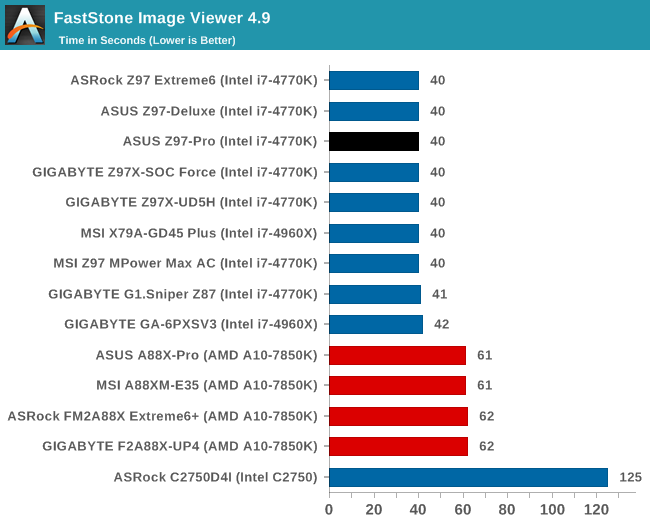
Video Conversion – Xilisoft Video Converter 7: link
The XVC test I normally do is updated to the full version of the software, and this time a different test as well. Here we take two different videos: a double UHD (3840x4320) clip of 10 minutes and a 640x266 DVD rip of a 2h20 film and convert both to iPod suitable formats. The reasoning here is simple – when frames are small enough to fit into memory, the algorithm has more chance to apply work between threads and process the video quicker. Results shown are in seconds and time taken to encode.
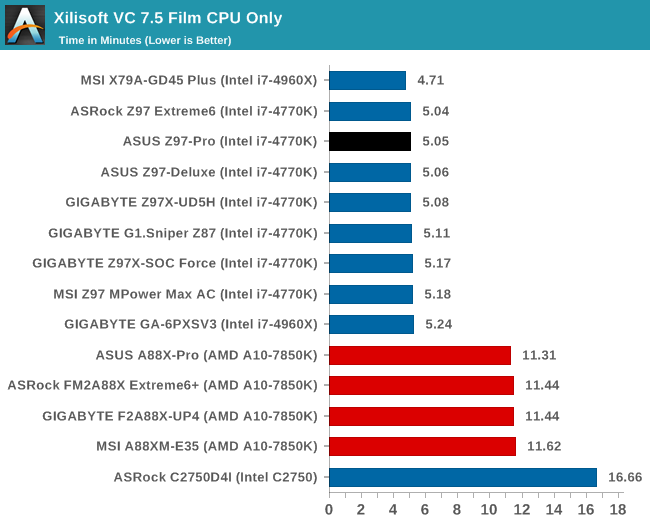

Video Conversion – Handbrake v0.9.9: link
Handbrake is a media conversion tool that was initially designed to help DVD ISOs and Video CDs into more common video formats. The principle today is still the same, primarily as an output for H.264 + AAC/MP3 audio within an MKV container. In our test we use the same videos as in the Xilisoft test, and results are given in frames per second.

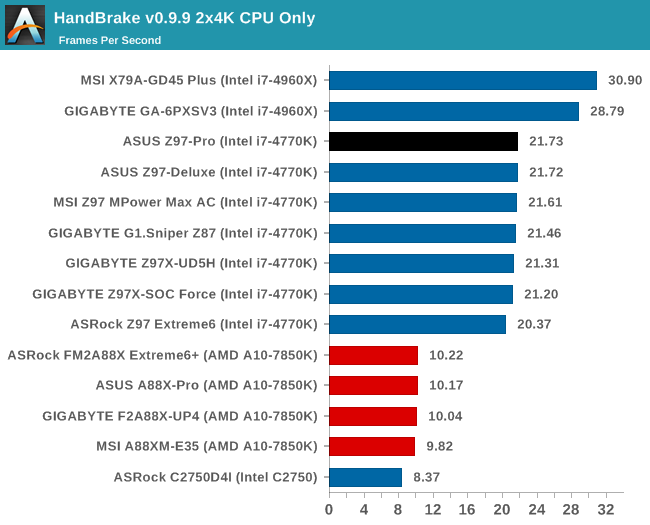
Rendering – PovRay 3.7: link
The Persistence of Vision RayTracer, or PovRay, is a freeware package for as the name suggests, ray tracing. It is a pure renderer, rather than modeling software, but the latest beta version contains a handy benchmark for stressing all processing threads on a platform. We have been using this test in motherboard reviews to test memory stability at various CPU speeds to good effect – if it passes the test, the IMC in the CPU is stable for a given CPU speed. As a CPU test, it runs for approximately 2-3 minutes on high end platforms.
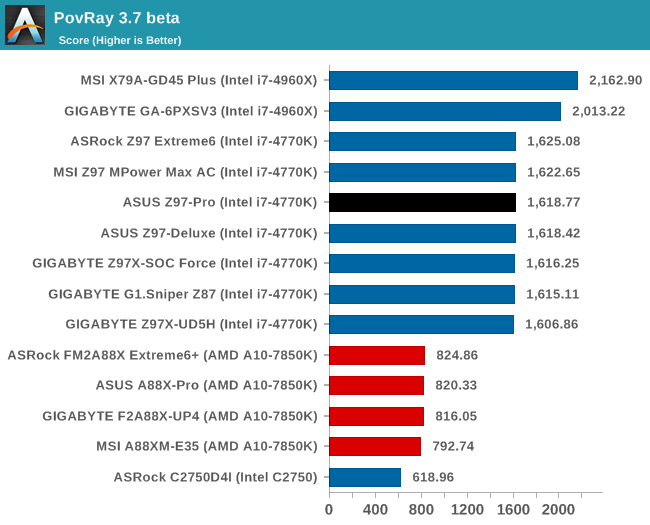
2D to 3D Rendering –Agisoft PhotoScan v1.0: link
Agisoft Photoscan creates 3D models from 2D images, a process which is very computationally expensive. The algorithm is split into four distinct phases, and different phases of the model reconstruction require either fast memory, fast IPC, more cores, or even OpenCL compute devices to hand. Agisoft supplied us with a special version of the software to script the process, where we take 50 images of a stately home and convert it into a medium quality model. This benchmark typically takes around 15-20 minutes on a high end PC on the CPU alone, with GPUs reducing the time.
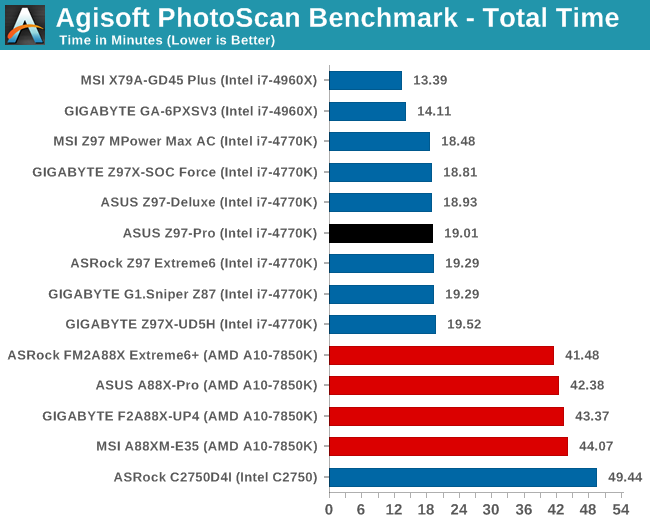
Console Emulation –Dolphin Benchmark: link
At the start of 2014 I was emailed with a link to a new emulation benchmark based on the Dolphin Emulator. The issue with emulators tends to be two-fold: game licensing and raw CPU power required for the emulation. As a result, many emulators are often bound by single thread CPU performance, and general reports tended to suggest that Haswell provided a significant boost to emulator performance. This benchmark runs a Wii program that raytraces a complex 3D scene inside the Dolphin Wii emulator. Performance on this benchmark is a good proxy of the speed of Dolphin CPU emulation, which is an intensive single core task using most aspects of a CPU. Results are given in minutes, where the Wii itself scores 17.53; meaning that anything above this is faster than an actual Wii for processing Wii code, albeit emulated.
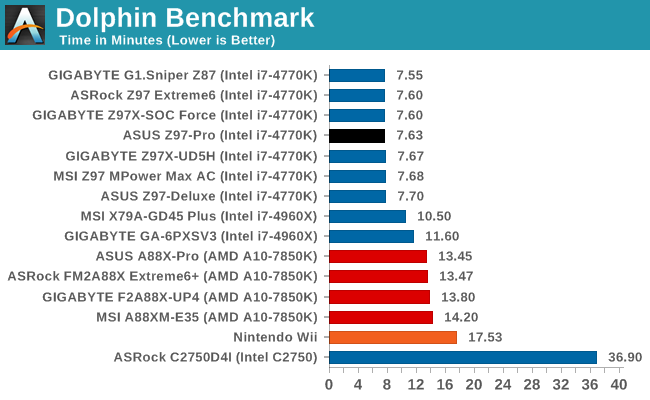
Point Calculations – 3D Movement Algorithm Test: link
3DPM is a self-penned benchmark, taking basic 3D movement algorithms used in Brownian Motion simulations and testing them for speed. High floating point performance, MHz and IPC wins in the single thread version, whereas the multithread version has to handle the threads and loves more cores.
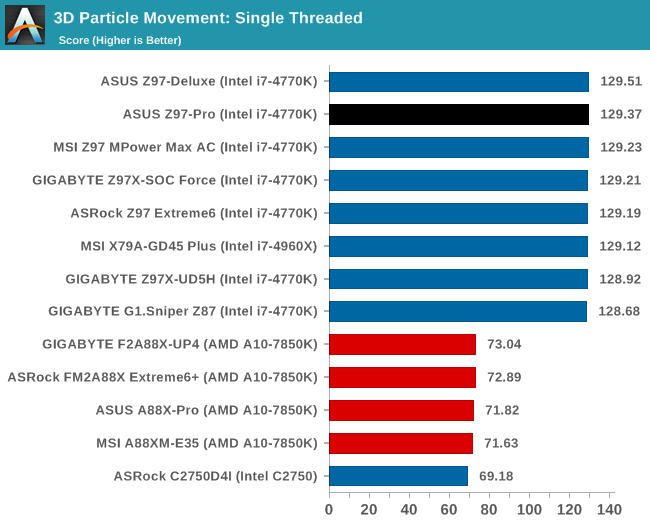
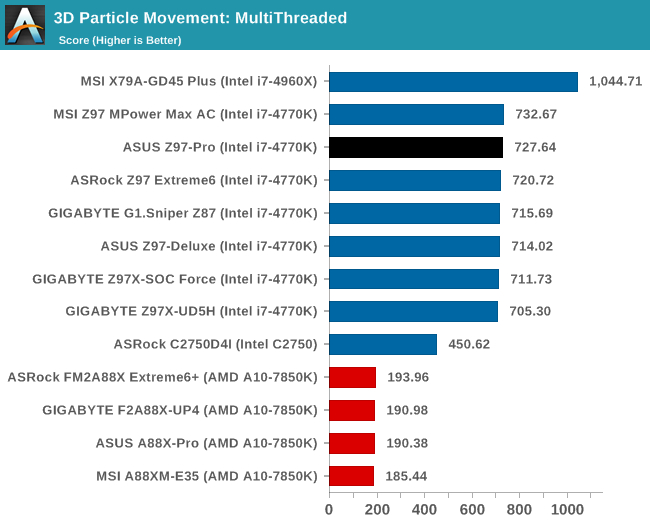
Synthetic – 7-Zip 9.2: link
As an open source compression tool, 7-Zip is a popular tool for making sets of files easier to handle and transfer. The software offers up its own benchmark, to which we report the result.
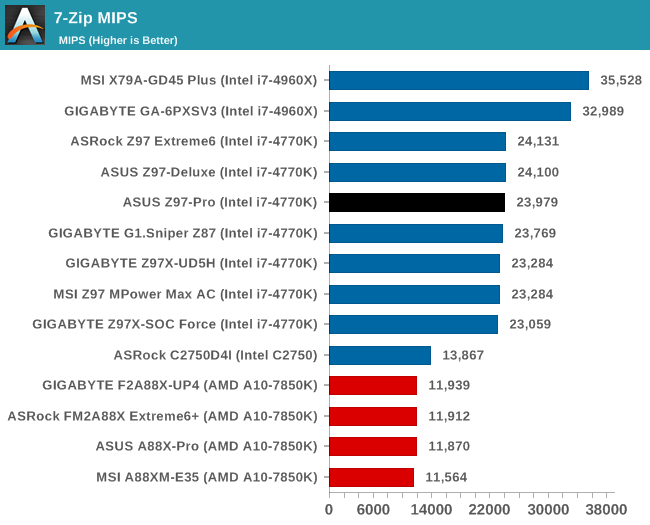










38 Comments
View All Comments
DanNeely - Wednesday, July 16, 2014 - link
Is the ASMedia USB3 controller a PCIe based controller or just a USB3 hub?Ian Cutress - Wednesday, July 16, 2014 - link
Controller, ASM1042AEhttp://www.asmedia.com.tw/eng/e_show_products.php?...
DanNeely - Wednesday, July 16, 2014 - link
Excellent. This board looks closer to my perfect spec than anything else I've seen reviewed so far. Add a PLX instead of toggling stuff off to run the 4x slot above 1x electrical, and 2 more USB ports in the empty space on the back and I'd call it perfect.Cellar Door - Wednesday, July 16, 2014 - link
Really??? No m2.sata - ASUS are not very forward thinking at the moment, sure they are pushing sataexpress but this is A DEAL BREAKER for me.Cellar Door - Wednesday, July 16, 2014 - link
My bad, I have no idea how I missed it...DanNeely - Wednesday, July 16, 2014 - link
1042 or 1142? The manual has no mention of a 1042 controller but does mention an ASMedia 1142 in the IRQ table. Google turns up ASmedia USB3 drivers for the 1142 but the chip itself appears to be missing from ASmedia's site so I can't confirm it's still a PCIe-USB3 chip and not a hub. I took a look at the full resolution top down image of the board to see if I could find it; but it fell just short of being high enough resolution to read the marking on the chips.DanNeely - Friday, July 18, 2014 - link
Found an article elsewhere claiming the 1142 controller does USB3.1. With Asus not advertising that feature I'm leaning toward the manual being in error...http://www.techpowerup.com/201559/msi-also-shows-o...
mapesdhs - Wednesday, July 16, 2014 - link
I helped a friend build a system using this mbd model last week, with a 4790K,
16GB/2400 TridentX, two GTX 580s, EVO 120GB, etc. He was thoroughly delighted,
said he'd never seen Windows fly so fast, from the initial install to the pace of updates.
By all accounts, a good board.
Ian.
willis936 - Wednesday, July 16, 2014 - link
Interesting choices. Did you get a good deal on the 580s?mapesdhs - Wednesday, July 16, 2014 - link
Sure, because my friend bought them from me. :D I have lots of them,
bought about 20 in the last year or so.
He uses them for accelerated rendering in Blender, for which two 580s
is quicker than a Titan but a lot cheaper (VRAM limits not withstanding).
My own system has four, faster than two Titan Blacks (AE/CUDA, Arion, Cycles).
I want to build a newer system for driving a 4K display in a few months' time,
but I'll probably get the Maximus VII Ranger instead. I also want to build an HTPC
for the same display, more for video and light-3D like Google Earth, will probably
get an ASUS Z97I-Plus for that as the price looks good for the features provided.
Might wait for Maxwells in both cases though.
Ian.